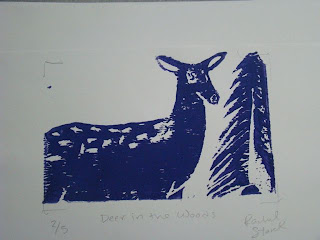1. I think my finished project is pretty balanced. I have the tree on the right and then the deer on the left, taking up most of the page. Maybe something could have been in the top left corner, but then again I wouldn't want the print to look too crowded.
2. To add texture and contrast to my print, I used one of the cutting tools to carve out the deer's spots, as well as the tree's branches. I made sure to make it kind of choppy to give it a better feel.
3. I used positive and negative space to create my image. First, I had to draw the picture out, then I figured out what I was going to cut out and what was going to stay by finding the positive and negative space within my drawing. I figured it would be easier to cut out the background than it would be to cut out the whole deer and tree so I decided the negative space would be the spots and background, and then positive space would be the deer and tree.
4. I would say overall my project was crafted pretty well. The nose and eye on the deer could have been made a little better if I'd had an even smaller tool, and the tree could have looked more tree like if I'd known how to make it have a more realistic texture.
5. I think I was able to achieve depth. There may be only two things in my print, but the fact that the deer is so much bigger than the tree establishes the fact that the deer is closer to the viewer than the tree is.
6. I think the Print Making project was fun. It was kind of annoying to have to trace the print multiple times onto multiple surfaces, and when we were rolling the ink out on the table it was harder than I thought it would be to get it up. It was fun carving into the stamp with the tools, but it was somewhat hard to do the small details with the tools provided.












